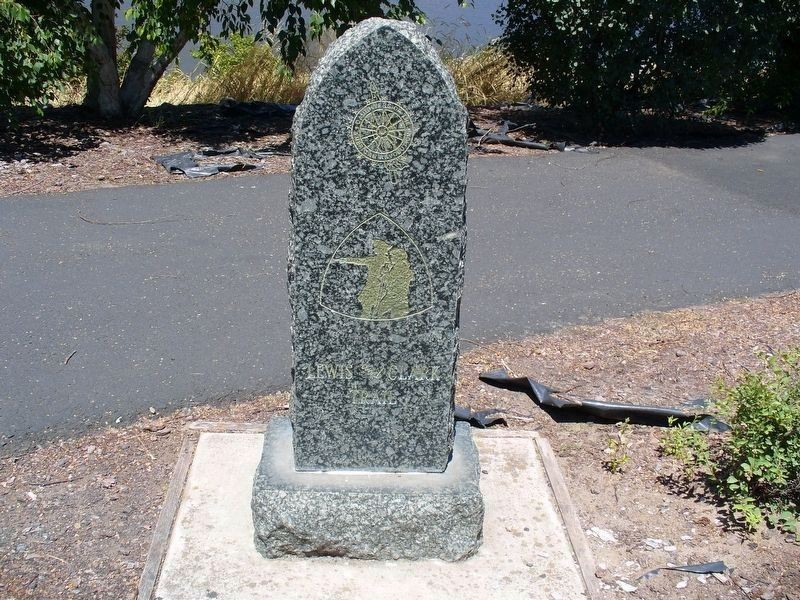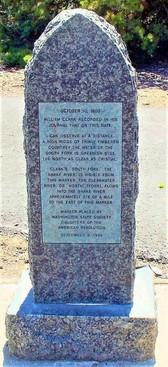Lewis and Clark Trail Marker - Clarkston, WA
Introduction
Text-to-speech Audio
Images
NSDAR insignia, the Lewis & Clark Corps of Discovery logo and the words “Lewis and Clark Trail” highlighted in gold leaf.

Excerpt: 1805 William Clark recorded in his journal that on this date: “I can observe at a distance... a high ridge of thinly timbered countrey the water of the south fork is greenish blue, the north as clear as crystial.” Clark’s ‘south fork’, the Snake

Backstory and Context
Text-to-speech Audio
The marker is 42" high and made of Lake Superior green granite. It is located in Granite Lake Park on the south bank of the Snake River across from the probable first Lewis and Clark campsite near Clarkston, Washington, in Asotin County. It is on Port Way, on the left when traveling east and is at or near this postal address: 850 Port Way, Clarkston WA 99403. The park is maintained by the Port of Clarkston and is landscaped with many plants that were native to the area at the time of the Lewis & Clark Expedition.
The Washington State DAR received a $10,000 grant from the National Park Service, under the direction of Richard Williams, for markers and the Tresko Monument company of Spokane contracted to make the markers. According to WSSDAR State Historian Leota King, the states of Kansas, Missouri, Montana, and Washington used the same stone and design to bring conformity to the Trail. Made of Lake Superior green granite, it is the third Lewis & Clark marker in a series of four.
Excerpt from Lewis & Clark Trail Heritage Foundation WA Chapter Newsletter, Nov 1999 edition: In 1998 when Shirley (Mrs. Robert) Wagers became Regent of the Washington State Society, Daughters of the American Revolution, she chose as her history project the placement of special markers along the Lewis and Clark Trail in Washington State. She was authorized the use of the same marker design used by the Kansas State Society three years ago when they placed markers at Lewis and Clark campsites along the Missouri River on Kansas' eastern border. A reception for the dedication guests was held in the port office after the ceremonies. John Tresko of Tresko Monuments in Spokane faithfully followed the patterns of the original marker… In the beginning, the original sites for the markers in Washington had been planned in state parks, but activities in the parks are now on hold until changes are made for the bicentennial... -submitted by Chapter Member Leota "Lee" King
The Captains wrote about the Indians and made lunar observations: "The Cho pun-nish or Pierced nose Indians are Stout likely men, handsom women, and verry dressey in their way, the dress of the men are a white Buffalow robe or Elk Skin dressed with Beeds which are generally white, Sea Shells - i e Mother of Pirl hung to ther hair and on a pice of otter Skin about their necks hair cerved in two parsels hanging forward over their Sholders, feathers, and different Coloured Paints which they find in their Countrey Generally white Green and light Blue. Some fiew were a Shirt of Dressed Skins and long legins, and Mockersons Painted, which appears to be their winter dress, with a plat of twisted grass about their necks."
Cite This Entry
Stirling, Shirley. "Lewis and Clark Trail Marker - Clarkston, WA." Clio: Your Guide to History. October 22, 2018. Accessed April 7, 2025. https://theclio.com/entry/68100
Sources
https://lewisandclarkjournals.unl.edu/journals/contents. University of Nebraska Press

